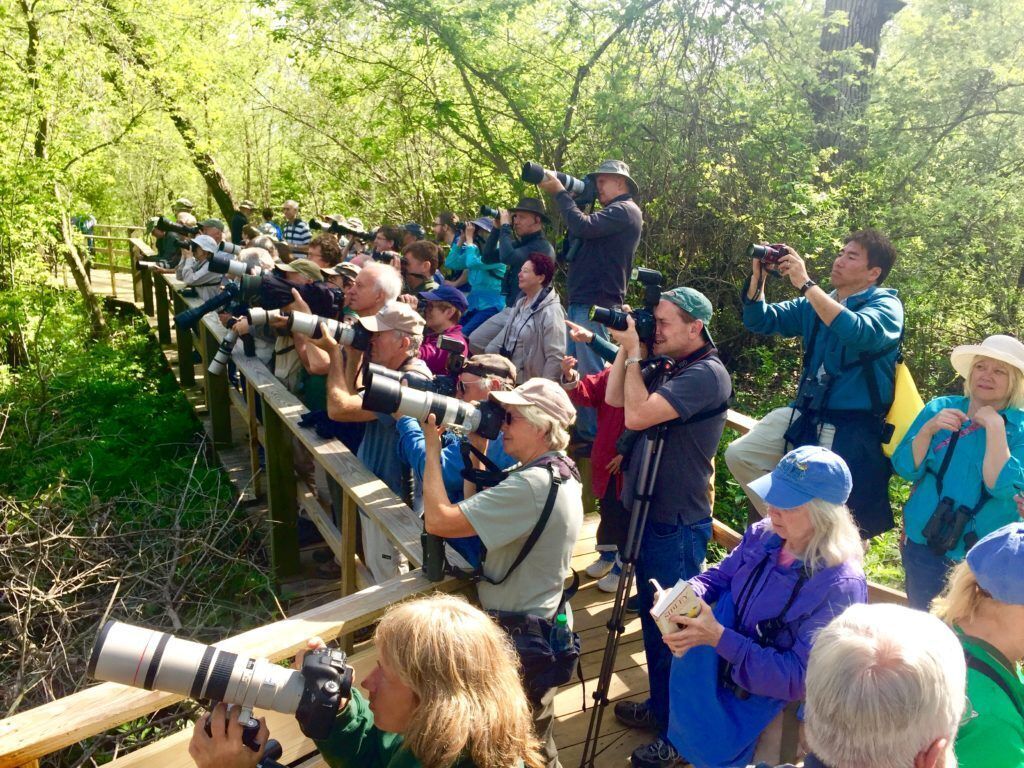Lake Erie and its importance to Birds
When one thinks about Lake Erie visions of boating and fishing and other recreational opportunities are often conjured up. But for a bird-watcher, the lake shores and open waters provide a spectacle like no other in the entire Great Lakes. Waterfowl galore pack marshes and the open lake waters, and interesting marsh birds breed in coastal wetlands. Winter brings hardy northern ducks, gulls, and raptors. There is never a dull season.

-
Why is Lake Erie such an attractive and important place for birds?
Lake Erie represents a barrier to most migrating passerines (perching birds) and raptors.
Many birds are reluctant to cross open water when the opposite shoreline cannot be seen, which results in major concentrations along the southwestern shore of Lake Erie in the spring, unparalleled in the Midwest. The opposite phenomenon occurs on the north shore of Lake Erie in autumn, making public areas like Long Point, Point Pelee, Holiday Beach and every private piece of habitat in between extremely valuable for resting and feeding areas for birds in migration.
With the exception of the Gulf coast, no other region of eastern North America can demonstrate concentrations of avian migrants like Lake Erie’s coastline. Important migratory pathways and habitat along Great Lakes shorelines have been identified at more than 60 sites; and 95% of the waterfowl counted on a recent Ohio Division of Wildlife aerial survey occurs in the Lake Erie marsh region.
The landscape along Lake Erie has been dramatically altered from pre-settlement conditions yet the region remains important for birds to rest and feed so they can continue their migration in good physiological condition. Unfortunately, habitat loss in the region continues, potentially jeopardizing the ability of birds to maintain sufficient condition to successfully complete their migration. Consequently, it is critical and urgent to define, protect, restore, and better manage migratory bird stopover sites in the western Lake Erie basin.
Birds at Lake Erie
The Lake Erie Marsh Region is recognized as globally important for migratory birds as millions of migratory songbirds, shorebirds, and waterfowl stop here to feed and rest every spring and fall during their long-distance migrations. Lake Erie shorelines and attendant inland natural areas are also home to a large number of permanent residents. Nearly 400 bird species have been documented in this region. Visiting birders travel to this region of northwest Ohio to observe and enjoy this spectacle, bringing millions of dollars to local lakeshore communities.
-
Waterbirds
As any true birder knows, birding opportunities in Northeast Ohio improve as the temperatures drop, the leaves fall and frost covers our car windshields in the morning. As the majority of songbirds and shorebirds have departed on the long journeys southward, waterfowl and boreal species begin to arrive in impressive numbers.
Birds that nested and fledged in the Arctic and on prairie potholes during the summer thrill local birders each fall, and promise to stick around until ice forms on area lakes, ponds and streams.
Occasional red-throated loons intermingle with hundreds of common loons, rafts of ruddy ducks & common goldeneyes, tens of thousands of mergansers and other diving ducks, thousands of gulls and hundreds of grebes which can be found annually during the spring and fall months along protected embayments of Lake Erie.
On a single aerial survey done on November 16 of this year, 201,016 water birds were counted, including ducks, geese, swans, cormorants and eagles, all within the offshore waters of western Lake Erie.
During the breeding season, off-shore islands provide nesting locations for colonies of gulls, cormorants, terns, egrets, and herons.
-
Raptors
The water bodies and associated habitats provide both thermals and prey to assist birds of prey (raptors) as they migrate. Raptor migration along the south shore of Lake Erie is unlike other well-known migration sites in that there is no single cliff face, ridge, or funneling point to concentrate soaring birds into one main flight path. Therefore, reluctant to cross the open waters of Lake Erie, where no thermals will form, these migrating hawks, vultures, accipiters, and eagles follow the lakeshore westward, curving around Maumee Bay and then head north for distant nesting grounds. Especially concentrated in early spring, as many as 1000 raptors may pass overhead daily.
-
Shorebirds
Lake Erie marshes make up the largest stopover habitats in the eastern United States between coastal habitats and northern breeding areas. More than 30 species of shorebirds migrate through the Lake Erie marshes each year, but different species as well as different ages within a species appear at different times of the year and choose different microhabitats.
Species timing, habitat availability and utilization all affect numbers of shorebirds use marshes and flooded farm fields during their twice-a-year migration through the Lake Erie watersheds. Sixty to 150,000 birds have been counted in the marsh region of NW Ohio in a single year. The Lake Erie marshes are the most important stopover sites between Cheyenne Bottoms in Kansas and Delaware Bay on the east coast. Research and bird counts have helped in including this area as part of the Western Hemisphere Shorebird Reserve Network (WHSRN). This designation exemplifies the value of these wetlands for supplying shorebirds with necessary habitat and food for their long-distance migration. Future land acquisition and restoration grants will be boosted in value because of this Regional Shorebird status.
The newly dedicated Lake Erie Birding Trail covers the entire 312 miles of Ohio shoreline, from Conneaut to Toledo. The Lake Erie shore and its immediate environs offer some of the best birding in the Great Lakes region. The 84 trail sites represent over 30 federal, state, county, and local park districts and management agencies.
In 2006, about 120,000 out-of-state-birders visited Ohio, with Lake Erie the most popular destination. Nationwide, birder expenditures total nearly $36 billion, and related industry benefits magnify this to about $82 billion in overall economic impact. As bird and other wildlife-watcher numbers continue to grow, it is important that local businesses realize the impact that these visitors have on their bottom line.
Birding Organizations Ohio
-
Cincinnati area
-
Lake County area
-
Elyria/Lorain area
-
Northwest Ohio
-
Sandusky area
-
Lake Erie islands
-
Cleveland area
-
Statewide
-
Toledo area


